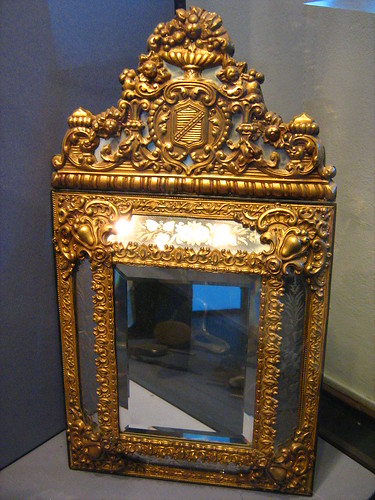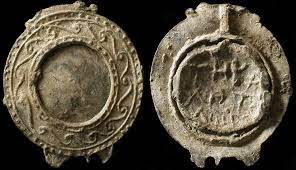The History of First Mirror, The idea of personal mirrors as tools for self-monitoring presupposes that a great deal of people have access to them. At least in the developed world, this is an empirical truth because mirrors are visibly commonplace. But how did this come to be? Reflective surfaces made of polished obsidian are the oldest “mirrors” in the archaeological record, dating back as far as 4000 BCE. The first evidence of mirrors as grooming tools dates to the 5th century BCE, in illustrations of elegant Greeks gazing at hand mirrors (these illustrations are found on antique pottery). These mirrors, made from a polished metal disk attached to a handle, did not contain any glass. The first real glass mirrors in the record are from the 3rd century AD, consisting of extremely small (a few square inches) concave or convex metal surfaces with glass coatings. The size and style of these early mirrors leads many archaelogists to believe that they were used as jewelry or amulets rather than for personal grooming (Melchoir-Bonnet 12). This image is of an ancient Roman lead casting for a mirror, which would have had a glass coating over the convex surface. It dates to the 2nd-3rd centuries AD.

This is an example of a polished metal reflective surface made of bronze. This piece never had any glass component. There were several critical issues that posed a challenge to glass mirror production throughout the ages. The most important obstacles were in creating untinted and uncolored glass, making large panes that were uniformly thin and flat, and finding a way to apply molten metal to the glass without inducing thermal cracks and breakage. Techniques of plane glassblowing and silvering were so elusive that successful methods were not reliably developed until around the 12th century AD. Different metal alloys and glassblowing techniques were common throughout different periods, but in the 13th – 15th centuries a surge of technical development yielded a clearly superior process, rooted in Venice, Italy. By the mid 1200s, there were accounts of the thriving glass making community in Venice, and this place was the epicenter of mirror making for several hundred years (Melchoir-Bonnet 19).
The Venetian industry exported its mirrors to royalty and private bourgeois clients across Europe in the late 1500’s and 1600’s, for equivalent prices in the range of several hundred to several thousand British pounds. Venetian mirrors were often worth more than fine art from high-renaissance painters like Raphael, which speaks to the valuable luxury of these items during this time (Melchoir-Bonnet 30). Although the Venetian industry sought to keep their techniques somewhat of a trade secret, competition from abroad eventually led to the rise in technical capacity of glassblowers from a range of cities and cultural centers throughout Europe. The high cost of mirrors, however, would keep them accessible only to the wealthiest bourgeois clients for some time to come.

There are many reasons for the bourgeois use of mirrors in European history. One interesting explanation, at least in France, was that the spread of the mirror in that region was contingent on Louis XIV’s 1689 decree that all private silver be confiscated to melt into coins to pay for military campaigns. As the rich had to let go of their fine jewelry and interior decorations made of the precious metal, mirrors became a replacement. Furniture, wall hangings, and other decorations became venues for mirrors as upper classes sought new ways to differentiate their homes and living spaces (Melchoir-Bonnet 71). Part of the allure of mirrors was that they provided additional lighting, as well as a perceived extension of space, both of which corresponded to a general artistic focus on light and optics during the 17th and 18th centuries in Europe. The domestic mirror thus became popularized by the bourgeois classes, which cultivated the trend toward common domestic usage as the technology became more affordable.
One of the most notable causes of more widespread mirror production was the difficulty of shipping them (due to fragility). Instead of consolidated mirror production in a small number of sites, it was safer and more quantitatively productive to spread mirror fabrication across a more diverse geography. Mirrors as personal grooming devices were simultaneously endorsed by the bourgeoisie in publications on household decor and social etiquette, which eventually reached the hands of the middle and lower classes as they aspired to more wealth and the privileged lifestyle that comes with it (Melchoir-Bonnet 96). Thus an increase in production and distribution capacity, coupled with the trend-setting social influence on the part of the bourgeoisie, made mirrors more accessible and desirable for the middle class.The popularization of the mirror is therefore, in part, a direct result of class-based hierarchies of social imagery. The following section of this project will discuss the concept of social psychology and its implications for the creation of image hierarchies, namely the ways that images are a source of power and identity formation in social exchanges.
A mirror is flat or curved surface usually produced of glass that has had a reflective coating applied to it. Mirrors are also used in technology and they are an important component in scientific instruments such as telescopes, industrial machinery, cameras and lasers. People probably first started to look at their reflections in pools of water, streams and rivers which were the first mirrors. The earliest man made mirrors were from polished stone and mirrors made form black volcanic glass obsidian. Some examples of this kind of mirrors have been found in Turkey dating back at least 6000 years. The Ancient Egyptians used polished copper to produce mirrors, and often the round face of the mirror would be embellished with ornamentation. The Ancient Mesopotamians also produced polished metal mirrors and mirrors made from polished stone were known in Central and South America from about 2000 BC. In China mirrors began to be made from metal alloys, a mixture of tin and copper called speculum metal that could be highly polished to made a reflective surface as well as mirrors made of polished bronze. Metal alloys or precious metals mirrors were very valuable items in ancient times only affordable to the very wealthy.
It is believed that mirrors made of metal-backed glass this type of mirror was first produced in Lebanon in the first century AD and the Romans made crude mirrors from blown glass with lead backings.
Mirror History and Origins of Mirrors
The ancient Egyptians, Romans and Greeks were quite fond of mirrors and often manufactured mirrors from polished copper and bronze. Glass mirrors were first produced during the third century A.D., and were quite common in Egypt, Gaul, Germany and Asia. The invention of glassblowing method during the 14th century led to the discovery of convex mirrors, which increased the popularity of glass mirrors…
Making Mirrors
A major mirror component is glass. Because glass is a poor reflector, it must be coated in order to make a mirror. The most appropriate materials for making metallic coatings are silver, gold, and chrome.
Facts about Mirrors
The concepts of the soul are often associated with mirrors, which results in a wealth of superstition surrounding mirrors. For instance, breaking a mirror causes seven years of bad luck because the soul which shatters with the broken mirror regenerates every seven years (old Roman legend). Mirrors also have a strong connection to spirits. Mirrors are covered when some dies, because according to some superstitions, a mirror can trap the soul of the person who dies.
Mirror Interesting Facts
During the period of the Renaissance in Europe, mirrors were made by a method of coating glass with a tin and mercury amalgam. In the sixteenth century, Venice became the centre of manufacture for such mirrors. A factory for manufacturing mirrors called Saint-Gobain was established in France, but mirrors were still expensive luxuries and only the very rich owned it.
In 1835 Justus von Liebig, a German chemist, developed the silvered-glass mirror where a thin layer of metallic silver is put onto glass by the chemical reduction of silver nitrate. The History of First Mirror The invention of this process enabled to mirrors being manufactured on a much larger scale, and for the first time in history ordinary people could buy a mirror. Present-day mirrors are more frequently produced by depositing aluminum by vacuum directly onto the glass.
There are many superstitions including mirrors. Breaking a mirror to this day is said to bring bad luck that lasts seven years. The History of First Mirror This curse is believed to go back to Roman times when they thought that it took seven years for a soul to renew itself. One of the ways that you could avoid the bad luck was to bury all pieces of broken mirror very deeply in the ground. The History of First Mirror It is also said that a mirror in the house falling from a wall is a sign that someone was going to die. It used to be common practice to cover up all mirrors in the house when somebody in a house died. It was believed that this prevent the soul of the deceased being trapped in one of the mirrors by the devil.






